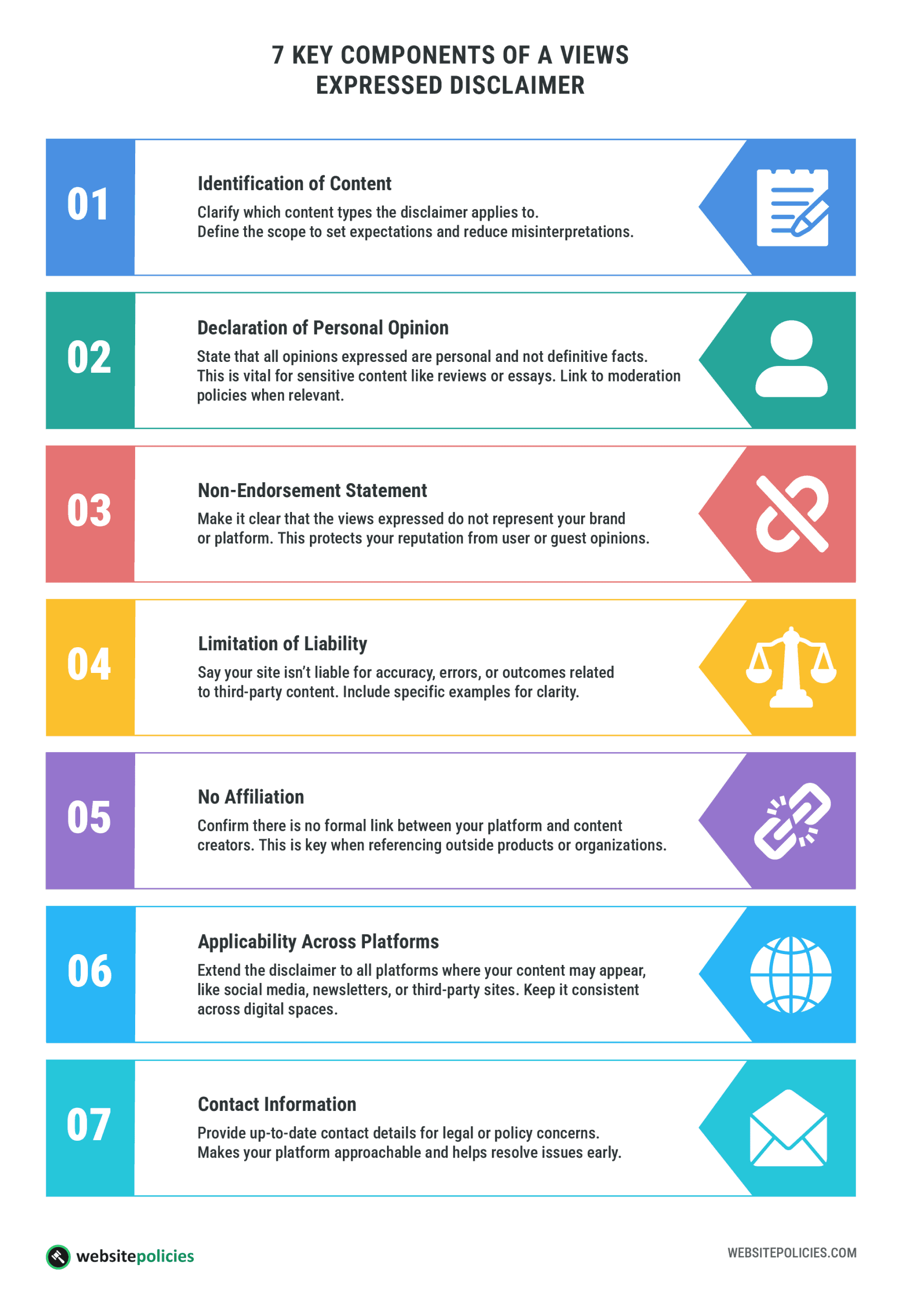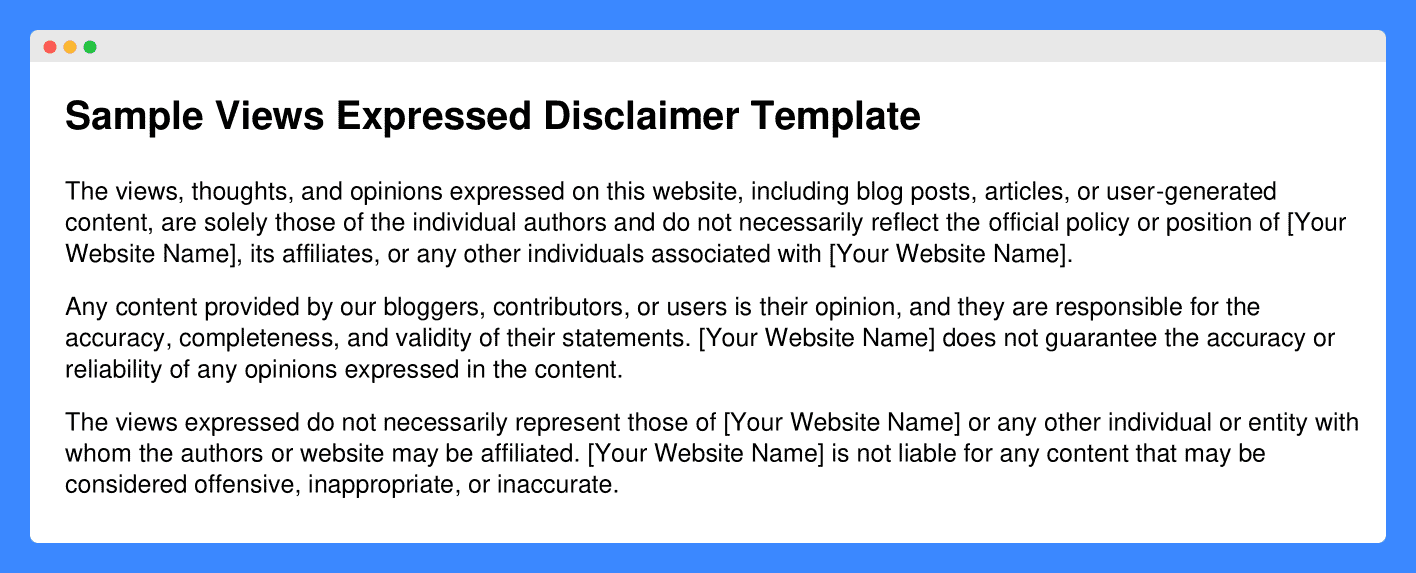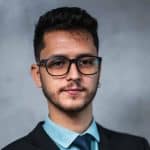Have you ever stumbled upon an opinion piece that made you wonder, “Does the whole company think this way?” Well, that’s where a views expressed disclaimer often comes in handy.
A views expressed disclaimer informs readers that they’re entering the realm of personal opinion. It clears the air by clarifying that the thoughts and opinions presented do not necessarily represent the views of the organization hosting the content.
Making sure everyone understands that these insights reflect the views of the individual alone can save a lot of mix-ups and misconceptions down the line.
For an online business owner like yourself, having this disclaimer means having a diverse range of voices on your platform while maintaining your brand’s integrity.
- A views expressed disclaimer clarifies that the opinions expressed are those of the individual author and not necessarily the company.
- You should include a views expressed disclaimer on your website and social media platforms if you allow user-generated content or guest contributions.
- Consider using a disclaimer generator as a starting point for your disclaimer. Always review and customize it to ensure it aligns with your specific needs and applicable laws.
Table of Contents
PRO TIP: Take the hassle of writing your own disclaimer away with our disclaimer generator trusted by over 200,000 businesses. It’ll save you hours of work and possible costly legal mistakes.
Who Needs a Views Expressed Disclaimer?
Almost any website or business that publishes content featuring the opinions and views of multiple contributors should include a disclaimer. This can include:
Media Publications
News sites, editorial publications, and magazines, among others, host a variety of views on current events. These platforms typically have multiple writers and guest contributors whose perspectives might not align with the publication’s official editorial stance.
A disclaimer stating that the views expressed in the content do not reflect that of the company ensures readers can differentiate between personal opinions and the publication’s views.
Blogs and Editorial Websites
Websites that feature guest bloggers or those run by a group of writers need this disclaimer. This way, they can clarify that the posts reflect the personal opinions of each contributor and not necessarily the overarching principles of the site.
Podcasts
Interview-based podcasts often dive deep into discussion and debate, featuring guests with distinct perspectives.
A views expressed disclaimer is crucial here to remind listeners that the thoughts and insights shared are those of the individual speakers and not the podcast hosts or sponsors.
E-commerce and Affiliate Websites
For sites that review products or offer buying guides, a disclaimer clarifies that the content may contain personal views. It also explains that product recommendations are independently chosen, regardless of potential commissions.
According to a 2023 survey, consumers trust peer recommendations.

This statistic underscores why it’s crucial for sites that offer product reviews or buying guides to clarify that their recommendations are independent and not influenced by potential commissions.
Health and Medical Advice Platforms
Sites that provide medical advice should always have a disclaimer to inform readers that the information provided is for educational purposes only and does not replace professional medical advice.
This is critical to prevent misunderstandings regarding the professional scope of the content shared.
If you run an online business, a views expressed disclaimer can help protect your brand. This clarity keeps you safe if a contributor’s opinion sparks controversy.
Why Do You Need a Views Expressed Disclaimer for Your Website?
You need a views expressed disclaimer for your website to manage expectations and mitigate risks. With one, you can help readers understand that the views expressed do not necessarily reflect those of your website or company.
Here’s a more detailed look at the reasons you need a views expressed disclaimer:
- Limit Legal Risks: A disclaimer can help limit your liability if controversial opinions are posted. It explains that these opinions belong solely to the contributor and not your business, reducing the chance of being held responsible for what others say.
- Protect Against Backlash: If a post sparks backlash, a disclaimer can act as a buffer. It will show that you do not endorse or guarantee the accuracy or reliability of the content, so you should not be liable for any damages that might arise.
- Set Boundaries with Third Parties: It can prevent misunderstandings with third parties, such as advertisers or sponsors, who might otherwise assume an agreement or endorsement from your side.
- Avoid Misrepresentation in Sensitive Areas: This is especially important if your site deals with topics like health, finance, or government. For instance, if covering anything related to the US Government, you need to disclaim official connection unless officially endorsed, as a warranty of accuracy or authority is not implied.
In essence, not having a disclaimer might prompt legal challenges, misinterpretations, and a potential reputational hit. You can mitigate all of these using this simple yet effective legal precaution.
A views expressed disclaimer does not guarantee that you will never face legal issues. However, it helps promptly address problems and protects your business from unnecessary risks.
7 Key Components of a Views Expressed Disclaimer
I know firsthand that solid views and opinions expressed disclaimer are like having a safety net. To help make sure you’re covered from all angles, include these key components:

1. Identification of Content
One of the first things you’ll want to do is write a clause specifying which types of content the disclaimer applies to. This can include blog posts, guest articles, comments, or social media posts.
Here’s how AskDrDorothy does it in its disclaimer:

By explicitly defining the types of content covered, AskDrDorothy makes it clear that the site hosts a range of personal opinions distinct from its official positions. This helps set realistic expectations and safeguards the site against potential misunderstandings.
2. Declaration of Personal Opinion
This crucial part of any opinion disclaimer is where you state that the content expressed is solely the personal opinion of the content creator. This is especially important if you allow user-generated content or guest contributions on your platform.
When drafting this part, I recommend mentioning scenarios relevant to your field—like reviews, critical essays, or personal stories. This helps reinforce the importance and intent of the disclaimer, especially when dealing with sensitive or divisive subjects.
Additionally, linking this to your content moderation policy could strengthen your legal standing by showing a proactive approach to managing diverse opinions.
PRO TIP: If your website features controversial or subjective topics, add an extra layer of specificity by emphasizing the personal nature of the content. Remind the readers it is not a definitive statement of fact.
3. Non-Endorsement Statement
This statement clarifies that the inclusion of any content on your platform does not imply endorsement of the views and opinions expressed within that content. This prevents associations that could mislead your audience or harm your brand’s reputation.
For instance, if a guest writer shares a controversial view on a sensitive topic, the non-endorsement statement ensures your audience understands these views are the writer’s alone, not the platform’s.
This not only supports a diverse range of ideas but also protects your site from being seen as biased or favoring certain viewpoints over others.
Here’s another example from Grist (formerly Pacific Standard Magazine), a non-profit media organization:

4. Limitation of Liability
Here is where you state that your website cannot be held responsible for the completeness, accuracy, or reliability of the information provided by third parties.
Furthermore, it also clarifies that no liability will be assumed for any errors, omissions, or inaccuracies, nor any losses, injuries, or damages arising from the display or use of this information.
This component helps to construe that your platform is merely a conduit for content provided by others. It also clarifies that it is not accountable for any oversight or negligence on the part of the content creators.
PRO TIP: Instead of broad terms, list specific examples of what you’re excluding. For example, you could say, “We are not responsible for any typos, factual errors, or outdated information.”
5. No Affiliation
While a non-endorsement clarifies that your business doesn’t endorse the views expressed, a no-affiliation statement goes a step further. It emphasizes that there’s no formal relationship or affiliation between your business and the content creator.
This is particularly important if the content creator engages in outside activities that might be perceived as conflicting with your business’ values or interests.
The blog One Hot Stove has a simple yet excellent example of this clause. On its Disclaimer page, you will find this:

This effectively communicates that while the blog may reference various products and services, these mentions are purely informational.
It’s a great model to follow if you want to keep your content credible while also safeguarding against potential legal complications or misunderstandings about your connections to the brands discussed.
6. Applicability Across Platforms
This part of your legal disclaimer is all about making sure it covers not just your main website but all digital spaces where your content might appear. Think social media pages, newsletters, or any third-party platforms where you might share content.
In the digital age, where your content might be republished or featured by other platforms, stating in your disclaimer that it applies universally ensures there’s no dilution of its effectiveness, no matter where the content lands.
In my case, I set up a protocol where my views expressed disclaimer is included as part of the package every time my content is used elsewhere. This way, the end user is presented with a consistent legal boundary.
For me, it’s about being proactive, like setting the ground rules that follow your content everywhere it goes.
PRO TIP: Update your disclaimer as needed to ensure it remains permissible under applicable laws and regulations. Regular audits can help you maintain the effectiveness of your legal protections.
7. Contact Information
Including clear contact details in your disclaimer serves as a direct line for concerns or questions, particularly if someone believes content on your site might breach or violate their rights or the stated policies of your platform.
Adding this information does more than just fulfill a legal checklist. It encourages engagement and trust by showing your audience that you are accessible and responsive to their concerns. It can also expedite the resolution of issues before they escalate.
Make sure the contact information is easy to find, up-to-date, and specific to legal or content-related inquiries to streamline communications and enhance user experience.
How Do You Write a Views Expressed Disclaimer for Your Business?
Writing a views expressed disclaimer for your business doesn’t have to be daunting. Here’s a simple step-by-step guide to help you craft one effectively:
Step 1: Determine Your Needs
Reflect on the nature of your business and the type of content you publish. Are you hosting guest posts, user-generated content, or expert opinions? Understanding who contributes and what they contribute will guide the framing of your disclaimer.
Step 2: Draft the Basic Disclaimer
Begin by writing a simple statement that can serve as the foundation of your disclaimer. This should state that opinions expressed are solely those of the contributors and not representative of your business.
Step 3: Customize for Specific Risks
Consider any specific risks associated with your content. For example, if you frequently cover controversial topics, strengthen your non-endorsement and liability clauses to protect your business from potential legal issues.
Step 4: Consult Legal Precedents
Look up disclaimers from similar businesses to see how they handle their own disclosures. This can provide insight into industry standards and help you craft a more robust disclaimer.
Step 5: Get Legal Feedback
Before finalizing your disclaimer, have it reviewed by a legal professional. This step ensures your disclaimer not only meets legal requirements but also effectively covers all potential liabilities specific to your business.
PRO TIP: Use a disclaimer generator to help streamline the process. These tools can provide a solid starting point to help you cover all the necessary legal bases.
Where To Display a Views Expressed Disclaimer
Display your views expressed disclaimer prominently on your website and across all platforms. The goal is to make it visible and easily accessible to anyone who needs to read it. Display it in:
- The footer of your website (incorporated within the privacy policy or as a standalone link)
- The About Us or Legal page
- Your social media profiles (as a section of your social media disclaimer in the bio)
- Before checkout for e-commerce sites
- At the start or end of blogs and articles
- Emails and newsletters
PRO TIP: The visibility and accessibility of your disclaimer should evolve with your digital presence. Regularly review it as you update or redesign your website and social media profiles.
Views Expressed Disclaimer Examples You Can Learn From
Curious about how to nail that views expressed disclaimer for your own site? Sometimes, the best way to learn is by example. Here are some standout examples from which to draw inspiration.
1. ScienceDaily
ScienceDaily offers a prime example of an effectively placed and clearly stated views expressed disclaimer. Located in the footer of their website, it reads:

This disclaimer not only fulfills the basic requirement of distancing the publication from the personal opinions of its contributors but also aligns strategically with its role as a science news aggregator.
Given that the site compiles research and articles from various scientific fields and contributors, the disclaimer plays a crucial role in maintaining scientific integrity and neutrality.
Moreover, it addresses potential legal implications. By stating the separation of opinion from endorsement, they mitigate the risk of being held accountable for misinterpretations or errors derived from external contributions.
2. TechCrunch
TechCrunch demonstrates an adept handling of views expressed disclaimers, particularly in cases where content originally published elsewhere is repurposed for their audience.

What sets this approach apart isn’t just the thorough dissociation from the author’s employer and associated entities. It’s also a solid explanation of the nature of the information presented.
They specify that the material is for informational purposes only and acknowledge the reliance on third-party sources that have not been independently verified by them.
3. Talking Movies With My Mom Podcast
While many podcasts include a disclaimer that covers the views of the hosts, Talking Movies With My Mom goes the extra mile to explicitly address the views of their guests. They state:

Moreover, the addition that “none of the guests or contributors to the Podcast will be held responsible for your use of the information contained herein” extends this protection to the guests themselves.
This part of the disclaimer reassures guests that their contributions to the discussions won’t later be held against them in contexts outside the podcast.
4. Joy FM Store
For e-commerce platforms, the Joy FM Store sets a great views expressed disclaimer example. Their dedicated Disclaimer page meticulously outlines the boundaries between the store’s official stance and the opinions shared by users in comments.

Furthermore, by stating that users “will take full responsibility, liability, and blame for any libel or litigation that results from something written in a comment,” the store sets a clear boundary.
This not only helps in moderating the community but also legally protects the company from being held accountable for what essentially are personal opinions aired in their public forums.
5. MedPage Today
MedPage Today provides a clear example of how medical professionals can share specialized knowledge while clearly distancing their personal opinions from their affiliated institutions.
At the end of the article by William R. Hoffman, MD, titled “There’s More to the Story of Pilots Avoiding Mental Health Care,” the author’s name is followed by a comprehensive disclaimer.
This disclaimer states:

Why is this important, especially in the medical field? Medical professionals often hold affiliations with various prestigious institutions, and their opinions could be misconstrued as representing those institutions.
By clearly stating that the views are solely those of Dr. Hoffman, MedPage Today helps prevent any misunderstandings about the source and authority of the information provided.
Sample Views Expressed Disclaimer Template
This expressed views disclaimer template offers a foundational guide for creating your own disclaimer for your website. While it covers the key elements, it’s important to adjust and customize the content to reflect your specific situation and ensure that any legal considerations are addressed.

Frequently Asked Questions
Do I need a views-expressed disclaimer for guest blog posts?
Yes, a views expressed disclaimer is crucial for guest blog posts. It clarifies that opinions are the author’s alone, not yours.
Should a views expressed disclaimer be included in all types of content?
Yes, include a views expressed disclaimer in all content types. It safeguards your brand by clarifying opinion ownership.
What happens if I don’t use a views-expressed disclaimer in my business content?
Not using a views-expressed disclaimer increases your legal liability. You could be held accountable for others’ opinions.
Is a views expressed disclaimer legally binding?
A views expressed disclaimer is legally binding if properly crafted. However, while it can help protect your business from liability, it does not guarantee legal immunity.
How often should I update my views expressed disclaimer?
Update your disclaimer annually to ensure its timeliness. Regular reviews keep it relevant and legally sound.



